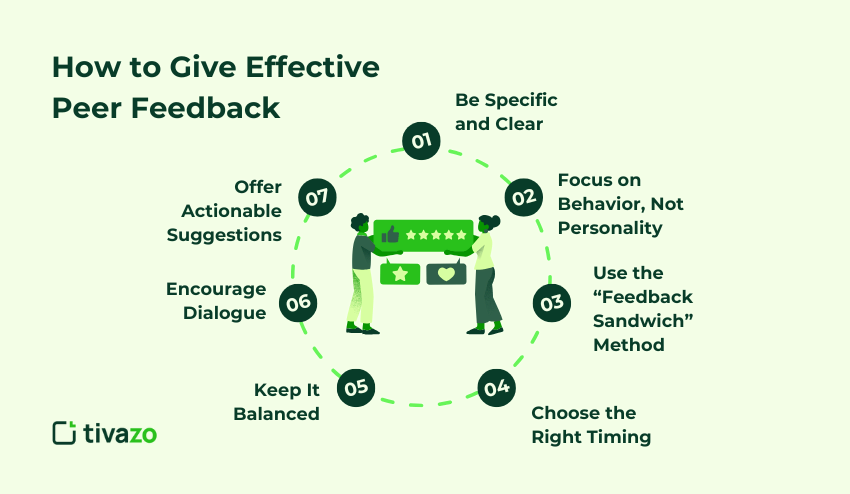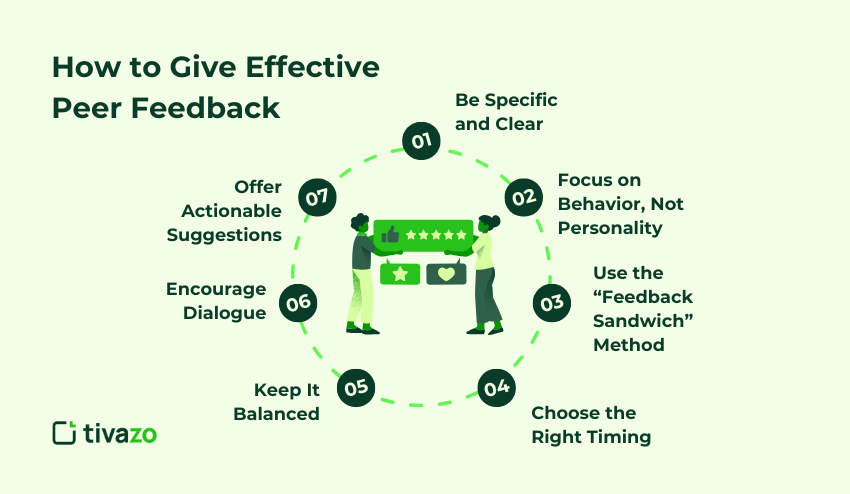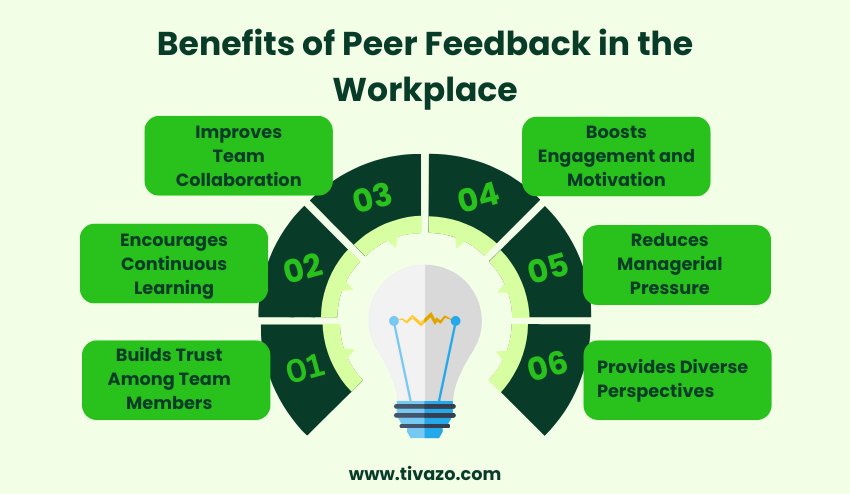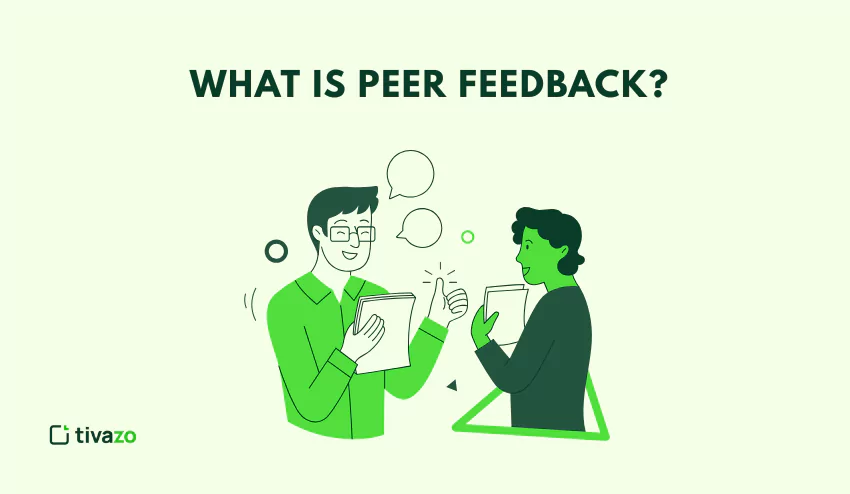Peer feedback is a critical component of personal and professional development. It is also done between colleagues, team members, or peers, unlike formal performance reviews, and provides real-time behavior, performance, and collaboration insights. Peer feedback, when done properly, promotes self-awareness, enhances communication and improves team productivity.
Most individuals are afraid to provide feedback or receive feedback because they are afraid of conflict, misunderstanding or negative feedback. Nonetheless, when peer feedback is mastered, it breeds a culture of trust, lifelong learning and accountability. In the workplaces, in school or in volunteer organizations, it can make people realize their strengths and weaknesses.
We are going to discuss the definition of peer feedback, the importance of peer feedback, its various forms, how to provide and receive feedback, common pitfalls, tools and templates, and steps to be taken in this guide to apply peer feedback in your daily life. You will have a roadmap to utilize peer feedback to grow and make your team successful by the end.
What is Peer Feedback?
Peer feedback is the act of exchanging positive comments, ideas or compliments with peers, classmates or teammates. It is a horizontal performance review between people of similar roles or levels as opposed to manager-led performance reviews. The aim is to offer an understanding of the work habits, behaviors, and results to develop growth, cooperation, and enhancement.
Peer feedback may be informal or formal. The formal feedback may be in the form of structured review cycles whereas the informal feedback may be during the everyday interactions like after a presentation or a team meeting. The two types are interested in enhancing performance and self-awareness.
Example Scenario: During a team meeting, a colleague realizes that your report had been researched well, but it is missing clarity in its recommendations. The ability to give feedback on particular sections will make you know what is good and what needs to be improved without being judgemental.
Peer feedback enhances relationships, develops trust, and increases the overall effectiveness of a team by promoting open communication and continuous improvement culture.
Why Peer Feedback Matters
Peer feedback is a very vital aspect of personal development, team and organizational growth. It transcends the conventional assessments by providing timely and actionable information that can assist people in bettering their behaviors and competencies.
Benefits for Individuals
- Improved Self-knowledge: Your peers will provide feedback on your strengths and weaknesses that you may not realize.
- Skill Development: Positive feedback assists in the development of certain skills, including the skills in communication and project implementation.
- Career Growth: Feedback on a regular basis will help in professional development and equip the individuals to take on greater responsibility.
Benefits for Teams
- Enhanced Cooperation: Open feedback helps in building trust and making team members collaborate more effectively.
- Increased Productivity: Workflow problems can be revealed and resolved in time to improve the overall performance.
- Enhanced Communication: Peer feedback promotes open and respectful interactions, which build team dynamics.
Example: A software development team relies on peer feedback to determine inefficiencies in the code review. Through sharing, the team eliminates mistakes, accelerates delivery, and enhances quality of products.
Types of Peer Feedback
There are various types of peer feedback, and each of them has a different purpose. The knowledge of the types will enable you to select the appropriate approach based on the situation.
1. Constructive Feedback
Concentrates on aspects that can be enhanced and can offer helpful suggestions. Helpful feedback provides a structure for helping the receiver to improve in a direct and non-evaluative way.
Example: The conclusion section of your report might be clearer. Consider summarizing the main points in bullet format.
2. Positive Reinforcement
Recognizes positive things and reinforces things that you want to see repeated. Boosts morale and motivation.
Sample: “I found your presentation very interesting and your diagrams helped me to digest complicated information.”
3. 360-Degree Feedback
Includes taking the input of various colleagues such as peers, subordinates and even managers. Gives a comprehensive perspective of performance and behavior.
Example: A project manager will take the input of team members, peers, and supervisors to be able to comprehend the effectiveness of leadership.
4. Real-Time Feedback
Feedback is given directly following an experience or action so that it is timely and contextualized; this can help individuals rapidly adjust behavior through feedback.
I remember a time someone praised me: “That was an awesome job on that question from the client! A suggestion here is to summarize their concern before answering; it is one of those tricks you could use next time.
5. Appreciative Feedback
Concentrates on rewarding efforts, accomplishments, and contributions, which strengthens positive action and participation.
Example: I would say I value the support you gave the team when the project was due last time. Your cooperation was of much account.
6. Developmental Feedback
Focuses on long-term expansion and not short-term solutions. It promotes learning, skills acquisition and career growth.
Example: I observed that you improved your skills in speaking in public. Think about attending a workshop to improve your presentation skills even more.
7. Peer-to-Peer Coaching
Feedback that does not only point out the gaps but also tells the colleague how to become better, almost like mentoring.
Example: I saw that you had problems with formatting the report. The following is a template that might be useful in making it more organized in the future.
8. Feedforward
Concentrates more on the future performance and not on the past mistakes. Helps peers learn how they should behave in the future or do better.
Practice: Next time you call your client, summarize the main points in the beginning. It would simplify your message and make it more effective.
How to Give Effective Peer Feedback
It is easy to feel awkward when giving feedback to peers; you need to help them but not to appear cruel. The trick is to be honest and empathetic at the same time making sure that your message is clear and actionable.

1. Be Specific and Clear
Do not use such ambiguous remarks as, good job or that needs work. Rather, refer to specific behaviors or actions.
Example: “Well-researched report, however, a busy reader would find it easier to read it with an executive summary at the beginning.
2. Focus on Behavior, Not Personality
Feedback must be focused on what one did and not who they are. This will avoid defensiveness and ensure the feedback is constructive.
E.g. instead of saying You are bad at making slides, say The slides were crowded with text.
3. Use the “Feedback Sandwich” Method
Begin with something positive, work on a weakness, and conclude with a positive note. This simplifies the message to accept.
Example: I enjoyed your enthusiasm in the meeting. Among the things to be careful of is allowing others to have more space to share. However, your vitality inspires the team, in general.
4. Choose the Right Timing
Provide feedback immediately after the event to ensure that the information is recent, but ensure that the timing is right. Critical feedback should not be provided in a group unless it is positive reinforcement.
5. Keep It Balanced
Excessive criticism might be demoralizing and excessive praise might not be motivating. Balance in order to encourage improvement and to be motivated.
6. Encourage Dialogue
The feedback must be a two-way dialogue and not a lecture. Ask friends to provide their views and opinions.
Sample: What do you feel did well in your presentation and what would you change?
7. Offer Actionable Suggestions
It is not enough to point out what is wrong, how to make it better. Feedback is more valuable when it is practical.
Example: “Rather than enumerating all the data points, attempt to draw a graph so that the trend becomes more pronounced.
How to Receive Peer Feedback Gracefully
It is significant to give feedback, yet it is equally important to know how to accept it. Most individuals find it hard to receive constructive criticism as they are usually on the defensive or discouraged side. Being taught to embrace feedback can help grow faster and develop better connections in the workplace.

1. Listen Without Interrupting
Listening When a peer provides feedback, listen. Do not cut them off or hurry to explain yourself. Give them a chance to complete their argument.
2. Keep an Open Mind
Feedback does not necessarily sound pleasant, but it usually carries with it some useful information. Attempt to view it as an opportunity and not an attack on oneself.
3. Ask Clarifying Questions
When it is not clear, request examples or recommendations. This demonstrates that you appreciate the feedback and are willing to make an improvement.
Sample: “Is there a particular point that you can identify where I had to interrupt in the meeting?
4. Avoid Defensiveness
It is normal to be motivated to defend what you are doing; however, overreacting by pushing too fast will close constructive dialogues. Rather, appreciate the input of the person and think later.
5. Take Notes
Note-taking of feedback will make you remember the important points and will provide you with something to think over later. It is also an indication to the giver that you care about what he has to say.
6. Show Appreciation
Although the feedback may be harsh, show appreciation. By saying, Thank you, I have noticed that, the culture of openness is promoted.
7. Act on the Feedback
The best way to learn is to do. Show your peers that their feedback matters by changing your style, manner, or behavior.
E.g., After receiving feedback about unclear emails, you begin writing shorter, structured emails. Ultimately, your team observes that communication has improved.
Benefits of Peer Feedback in the Workplace
Peer feedback is not only an improvement tool, it is a culture-building practice that enhances teams and improves performance. Workplaces will be more open, collaborative, and growth-oriented when employees frequently share feedback.

1. Builds Trust Among Team Members
The truthful and respectful feedback can build stronger relationships. Sharing of insights with peers in a non-judgmental manner leads to trust and respect.
2. Encourages Continuous Learning
In comparison to yearly reviews, peer feedback is real-time. This brings constant learning and improvement opportunities rather than months of waiting until the formal evaluations.
3. Improves Team Collaboration
The feedback identifies the strengths and weaknesses, and this allows team members to organize themselves in a more coordinated way. To illustrate, when a person realizes that he/she is dominating discussions, one can change and make others participate.
4. Boosts Engagement and Motivation
Workers who get positive feedbacks through their colleagues feel appreciated. This appreciation boosts morale and encourages people to do well.
5. Reduces Managerial Pressure
Managers do not need to be the only provider of feedback. P2P reviews distribute the burden among the team, which reduces the workload of the manager besides fostering responsibility.
6. Provides Diverse Perspectives
Managers do not always see what peers see. Comments of colleagues who work directly on the projects provide new and up-to-date information that makes the results better.
Mini Case Study:
Planned peer feedbacks every two weeks were introduced by a marketing team. In three months, they realized the reduction of conflicts, easier workflow, and the speed of campaign delivery had increased by 15 percent.
Common Mistakes to Avoid When Giving Peer Feedback
Despite the intentions, peer feedback may fail if not provided in a well-thought manner. Any misstep may result in misunderstanding, offended feelings, and even conflict in a team. Knowing the pitfalls to avoid makes you avoid them and makes your feedback constructive.
1. Being Too Vague
Telling someone that they should do better does not give any good guidance. Your peer will not be aware of what to change or improve without specifics.
Improved strategy: Indicate a specific one, like, in the last meeting, the data slide was difficult to follow. It would be better to add a chart.
2. Making It Personal
The feedback must be behavioral, rather than personal. Such remarks as You are lazy, You are not a good team player may seem like personal attacks.
More effective: Put it in terms of actions: “The project deadline was not met due to the lack of sharing updates in time.
3. Overloading With Criticism
It is better not to dump too many negative points on your peer in one go because this may overpower your peer and make your message less effective.
Better solution: Focus on one or two important areas to talk about and compensate them by positive feedback.
4. Delivering Feedback at the Wrong Time
It may be embarrassing or defensive to provide feedback when one is experiencing high emotions or when others are present.
Better strategy: Select an opportune time and when the need arises provide feedback privately.
5. Ignoring Follow-Up
The feedback without follow-up can make peers not know whether they have improved.
More appropriate: Come back later to give an update on the progress or give further instructions where necessary.
6. Failing to Offer Solutions
It may seem unproductive to highlight issues without proposing solutions to enhance the situation.
Wiser choice: Combine observations with real-life examples or materials that your peer can apply.
Conclusion
Peer feedback is not only about correcting mistakes, but also about the provision of the environment where everyone could develop, cooperate, and achieve success. When properly carried out, it enhances self-awareness, builds relationships and elevates the level of team performance.
To the people, it is acquiring new skills and career development. In the case of teams, it fosters trust, eases the working process, and makes projects more efficient. And in the case of organizations it creates a culture of continuous improvement that leads to long-term success.
It is all about balance: one has to be honest and respectful in giving feedback, and open and willing to take action in receiving it. Peer feedback is one of the strongest tools of development in any work environment when both parties are invested.




